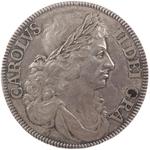The English Crown was a large silver coin with a value of five shillings (at twelve pence per shilling, equal to 60 pence, or one quarter of a pound - the pound being twenty shillings). Originally known as the "crown of the double rose", the denomination was introduced as part of King Henry VIII's monetary reform of 1526, and was initially made of gold. The first silver crowns were produced in 1551 during the brief reign of King Edward VI.
The Petition Crown was a pattern coin produced in 1663 by Thomas Simon, a celebrated English medallist and coin designer. The coin was submitted directly by the artist to King Charles II as a personal "petition" against the contemporary coins designed by the Flemish brothers John and Joseph Roettiers, and for the further Royal consideration that only Simon's designs be used for all future specie now that machine-made currency had been adopted universally for the production of British coinage.
The rivalry between the Roettiers brothers and Thomas Simon resulted from a Royal competition to design this new milled coinage. For unclear reasons, Simon did not submit his trial design in time, resulting in the Flemish engravers winning by default and their coinage being issued for circulation in 1662. However Simon's desire to win back the King's affections resulted in the development of this trial piece the following year. Not only did it dramatically differ from the coins produced by the Roettiers brothers, but also bore his "petition" engraved in 200 letters in two lines around the coin's edge:
THOMAS SIMON MOST HVMBLY PRAYS YOVR MAJESTY TO COMPARE THIS HIS TRYALL PIECE WITH THE DVTCH AND IF MORE TRVLY DRAWN & EMBOSS'D MORE GRACE; FVLLY ORDER'D AND MORE ACCURATELY ENGRAVEN TO RELEIVE HIM [sic].
Even more impressive than the two lines is the fact that the inscription is not all around the edge but only a small part of it, the rest being covered with the kings' monogram of two crossed letters C, crowned.
The reverse of the coin is slightly convex and the obverse concave to show the King as a stronger feature of the coin. Ultimately however the Roettier brothers continued to produce the dies for the crowns, albeit from 1664 with subtle corrections as a result of the influence of Simon's pattern.
The adoption of edge lettering on British coinage began under Oliver Cromwell, when Thomas Simon was engraver of dies at the Royal Mint and where he also produced the State Seal of the Commonwealth. The markings were intended to guard against the contemporary practice of clipping or the shaving of precious metal off the edges of a coin for illicit personal gain. At the time of production, Charles II's coinage bore the Latin phrase DECVS ET TVTAMEN (An Ornament and a Safeguard) in relation to this practice. This phrase was still being used on British coins until the revision of the pound coin in 2015.
Whilst the market price for examples has fluctuated dramatically over the centuries, the coin's spectacular artistry and noted rarity have gained it a passionate following amongst numismatists. Today the coin is known from only a handful of examples and is extremely sought after. Consequently copies of the coin known as electrotypes have been made for collectors who were otherwise unable to afford the artist's original. In March 2023 the Royal Mint released a range of modern commemorative coinage inspired by the 1663 "petition crown", celebrating 360 years since the original pattern coin was struck. | 





 Search for England: Petition Crown 1663 on eBay
Search for England: Petition Crown 1663 on eBay 
